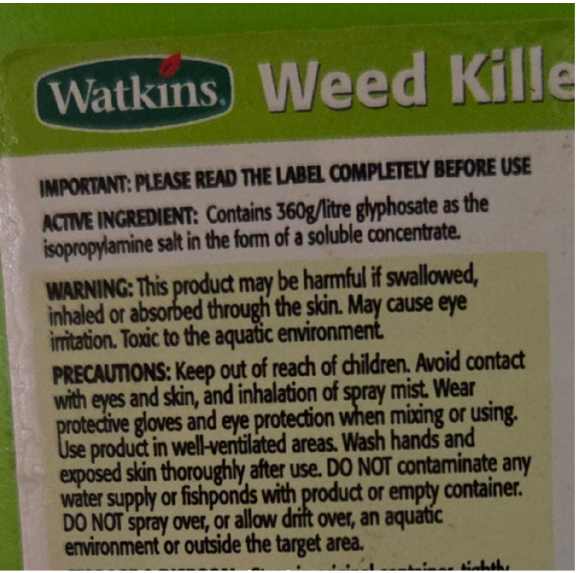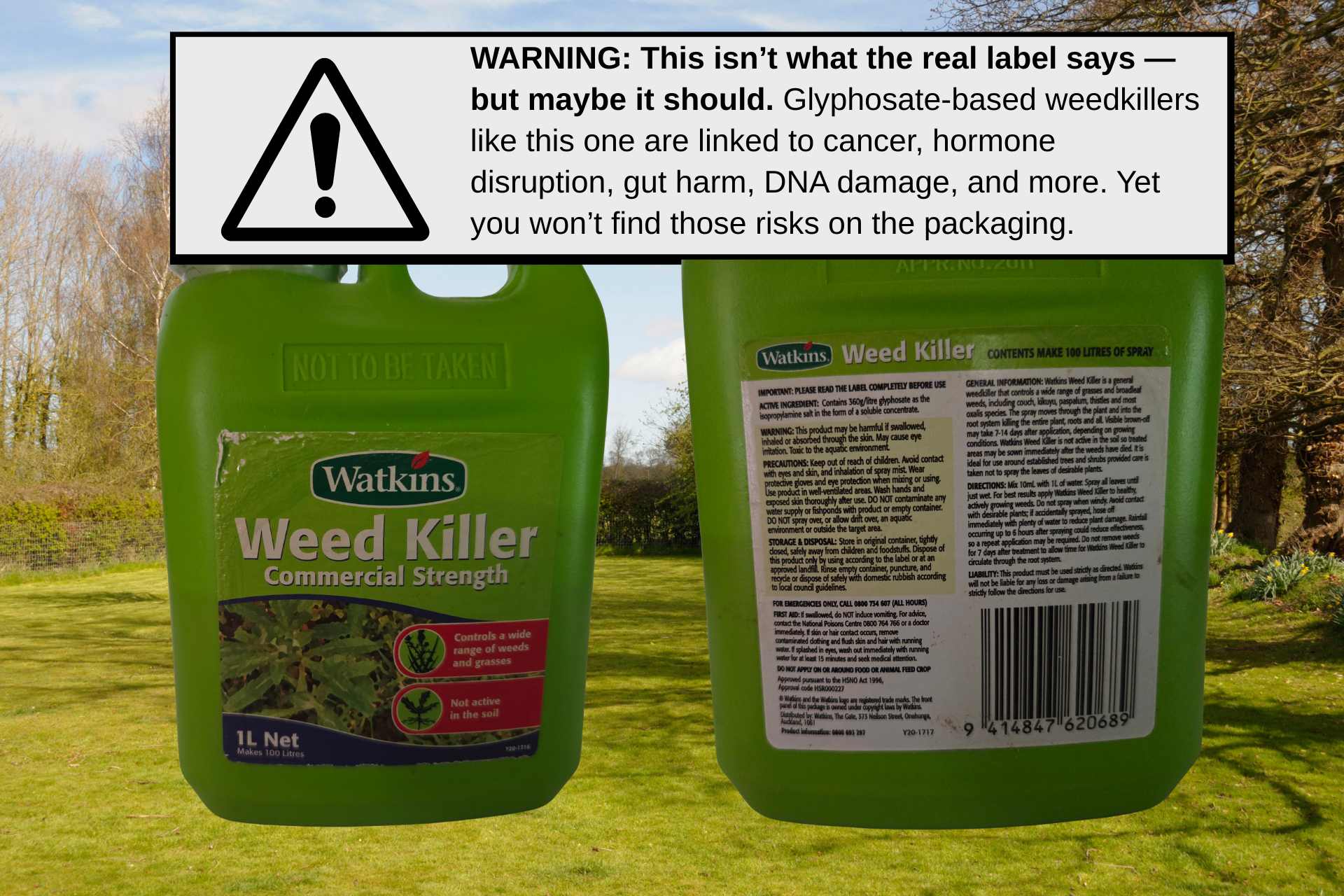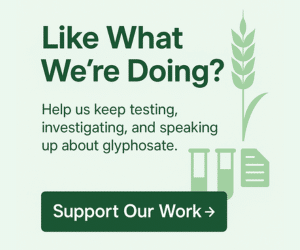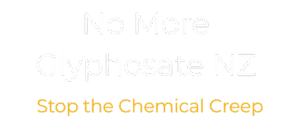When we wrote to the Minister for the Environment, we thought we were asking a simple question.
We weren’t calling for a ban — just asking a simple question.
We simply asked why glyphosate-based weedkillers — the ones sold to everyday consumers in shops and garden centres — don’t carry clearer health warnings.
After all, these are products that people spray around their lawns, near their children and pets, and sometimes even on homegrown food. Shouldn’t the public be informed about what they’re using?
We weren’t talking about glyphosate in isolation — the pure, technical-grade active ingredient. We were talking about the actual chemical formulations sold on shelves: Roundup, Yates Zero, Watkins Commercial Strength, Weedmaster TS540, and others like them.
So we asked the Minister: why don’t these real-world products carry the kind of warnings you’d find on far less hazardous household items — even toothpaste?
Our Letter to the Minister for the Environment
On 9 October 2025, we sent the following email to Hon Penny Simmonds, Minister for the Environment.
Dear Ms Simmonds,
I am writing to you as Minister for the Environment regarding the Environmental Protection Authority’s oversight of glyphosate-based products.
Glyphosate-based weedkillers such as Roundup are sold freely in New Zealand. Yet unlike tobacco, alcohol, or even energy drinks, these products carry no health warning labels. Even everyday items like toothpaste are required to display warnings to seek professional help or contact a poison control center immediately if swallowed. The absence of any comparable warnings on glyphosate-based weedkillers — products classified internationally as probable carcinogens — is difficult to justify.
The International Agency for Research on Cancer classified glyphosate as a probable human carcinogen in 2015. Since then, courts overseas have awarded substantial damages to individuals harmed by glyphosate-based formulations. Even as debate continues, these developments demonstrate that precautionary action is warranted.
I therefore ask:
- Why does the EPA not require warning labels on glyphosate-based weedkillers sold to the public?
- Will you direct the EPA to review labeling requirements to ensure consumers are warned of potential health risks, as they already are with tobacco, alcohol, energy drinks, and even household products like toothpaste?
This is not about banning glyphosate. It is about protecting the public’s right to know and ensuring families are properly informed about the risks of products they buy off the shelf.
I look forward to your reply.
The Minister’s Response — But Not to the Question We Asked
A month later, on 10 November 2025, we received the following response — and immediately noticed a critical oversight.
Because the Minister’s response focused entirely on glyphosate itself — not the commercial formulations New Zealanders are actually buying and using.
Here’s her reply:
Thank you for your email of 9 October 2025 regarding the labelling requirements for glyphosate.
Under the Hazardous Substances and New Organisms Act 1996 (HSNO Act), all hazardous substances, including substances containing glyphosate, must comply with the Consolidated Hazardous Substances (Labelling) Notice 2017. Labels must include information on the hazards of the substance, how to use and store it safely, and emergency management, such as first aid. More information on the rules for labelling hazardous substances is available here: https://www.epa.govt.nz/hazardous-substances/safety-data-sheets-labelling-andpackaging/labelling/.
Individual glyphosate-containing products may have different hazard classifications depending on its formulation and concentration. I do not consider it necessary to direct the EPA to include further labelling beyond that currently required, as this already includes warnings, instructions and a contact number in case of emergency.
If you believe that a hazardous substance does not comply with the requirements of the EPA’s labelling notice, you contact the EPA’s Compliance, Monitoring and Enforcement (CME) team directly at compliance@epa.govt.nz.
Regulators from jurisdictions including the European Union, Australia, and the United States have extensively reviewed glyphosate. They concluded it should not be classified as a carcinogen and that risks of using glyphosate can be managed through labelling, instructions and personal protective equipment, depending on the formulation.
The Environmental Protection Authority (EPA) recently considered whether there were grounds to reassess glyphosate. The EPA determined that, based on extensive and comprehensive reviews by international regulators, the risks associated with the use of glyphosate had not significantly changed such as to warrant a reassessment. For more information on the glyphosate reassessment please see: https://www.epa.govt.nz/database-search/hsno-application-register/view/APP204718/.
I am advised by the EPA that if new information did become available that indicated a change in controls or the hazard classification for glyphosate, the EPA would consider it to ensure any risks to human health and the environment were managed.
Yours sincerely
Hon Penny Simmonds
Minister for the Environment
At first glance, this may sound reasonable. But dig deeper, and you’ll notice a critical blind spot.
What’s Actually in Glyphosate-Based Weedkillers?
This is the crux of the issue — and it’s not a minor detail.
When government agencies talk about glyphosate, they’re referring to the active ingredient in its purest, laboratory-grade form. But that’s not what New Zealanders are buying off the shelf, and it’s certainly not what they’re spraying on their lawns, driveways, or paddocks.
What’s actually being sold are glyphosate-based formulations — mixtures that combine glyphosate with other chemicals like surfactants, solvents, preservatives, and sticking agents. These additives are included to help the spray penetrate leaves, cling to surfaces, and resist rain. They’re what make the product work in the real world.
And here’s the key point:
These co-formulants can significantly alter the safety profile of the product. Some increase toxicity. Some may harm aquatic life or pollinators. Some are suspected of causing chronic health effects on their own — even when glyphosate is ruled out.
So when a label only refers to glyphosate, or when a Minister replies to a question about Roundup by citing studies on glyphosate alone, it misses the point entirely.
Because no one is spraying pure glyphosate.
They’re spraying formulated products — chemical cocktails — often with little knowledge of what’s actually in them or what the combined risks might be.
Glyphosate Product Labels: What the Public Sees vs What’s Missing
Let’s take a close look at what a typical shelf‑product label actually shows — the one the average New Zealander browses, picks up, sprays, tracks into the house, maybe sprays close to children or neighbours. Because the mismatch between what we ask for and what we see is stark.
What the label says

Note: We’re not picking on Watkins. This product is simply a representative example of how glyphosate-based herbicide labels typically appear in New Zealand. The same limited warnings and ingredient disclosures can be found across many common brands — despite their legal obligation to reflect the full hazards of the formulated product, not just glyphosate.
Take for example Watkins Weedkiller Commercial Strength. According to the official product page:
- Active Ingredient – “360 g/L glyphosate as the isopropylamine salt in the form of a soluble concentrate.”
- Under “WARNING”: “This product may be harmful if swallowed, inhaled or absorbed through the skin. May cause eye irritation. Toxic to the aquatic environment.”
- Precautions: a “Precautions” section instructs users to “Keep out of reach of children. Avoid contact with eyes, skin and inhalation of spray mist. Wear protective gloves and eye protection when mixing or using. Use product in well‑ventilated areas. Wash any exposed skin thoroughly after use. DO NOT contaminate any water supply or fishponds… DO NOT spray over, or allow drift over, an aquatic environment or outside the target area.”
So far: it lists the glyphosate concentration and gives general hazard / aquatic environment warnings.
What Glyphosate Product Labels Leave Out — And Why It Matters
No mention of co‑formulants or surfactants
The label lists only the active ingredient (glyphosate). It does not list the surfactants, sticking agents, solvents or “inert” co‑formulants that typically accompany formulated herbicides. Yet these are relevant to risk. By listing only glyphosate, the label hides the presence of a chemical cocktail — and its associated risks..
No explicit chronic health warning
The warnings focus on immediate hazards (swallowing, skin contact, eye irritation) and environmental toxicity (aquatic life). They do not feature warnings about long‑term exposure, possible reproductive or endocrine effects, microbiome disruption or other emerging concerns (which our site has covered elsewhere). That’s a gap given the controversies around formulated products and co‑formulants.
No alert to specific vulnerable receptors like bees, pollinators or other non‑human species
Although the aquatic toxicity is mentioned, there is no visible statement on‑label about “avoid spraying when bees are present”, “protect pollinators”, or “avoid drift to flowering plants”. For an herbicide used in gardens, driveways or edge spaces this omission may matter.
Generic language vs. product in everyday settings
“May be harmful if swallowed, inhaled or absorbed through the skin.” That’s valid — but how many households interpret that as “may cause serious long‑term health issues” versus “just don’t get it on you”? When the label lumps it into a broad generic hazard, rather than a specific “possible chronic exposure risk”, the user may underestimate the real‐world risk scenarios.
Why this disconnect matters
- The public buys and uses formulated products not just “technical‑grade glyphosate”. Yet many regulatory responses (as we noted in our correspondence with the Minister) treat glyphosate in isolation, not the full formulation. So the label we see becomes the frontline of consumer awareness — and it’s missing pieces.
- If the label doesn’t clearly communicate the formulation hazards or list the non‑glyphosate components, the average user doesn’t have full transparency. That undermines the “right to know” and informed consent which underpins your campaign.
- Labels in real‑life settings are what matter for day‑to‑day exposure patterns: family spraying near a veggie patch, a child running over a recently treated surface, a pet walking through a sprayed zone. The label’s framing affects how people treat those circumstances.
- Because there appears to be a regulatory focus on the active ingredient rather than the commercial formulation (as seen in the Minister’s reply), the mismatch between what’s required on the label and what the product actually contains becomes amplified.
Is the EPA Enforcing Glyphosate Label Laws?
Under New Zealand’s Hazardous Substances and New Organisms (HSNO) Act, any hazardous substance sold or supplied to the public must be labelled to reflect the hazards of the product as formulated — not just the active ingredient.
That means products like Roundup or Watkins Commercial Strength Weedkiller are legally required to carry labels that account for all relevant risks associated with the final mixture. This includes any co-formulants — the solvents, surfactants, and so-called “inert” ingredients that may:
- amplify toxicity,
- increase skin or eye absorption,
- alter environmental persistence, or
- pose risks to non-target species like bees, aquatic life, or soil organisms.
The Environmental Protection Authority’s own guidance supports this. It states that:
“All hazardous substances must be labelled to identify the hazards of the substance and how to use it safely.”
And that hazard classification is based on the properties of the substance “as it is imported, manufactured, or supplied.”
Source: EPA Labelling Guidance
So why do many glyphosate-based products — including those sold for household use — list only glyphosate under “Active Ingredient,” with no mention of co-formulants or long-term health risks?
If those additional ingredients are part of the product — and if they carry risks, as many international studies suggest — then the current labels may not comply with the law.
Which brings us to the bigger question: If the rules already require it — why aren’t we seeing it on the shelf?
The EPA Isn’t Being Asked the Right Questions
The Minister directed us to contact the EPA’s Compliance team if we believe a product label doesn’t meet the current rules.
But that puts the burden back on the public — and misses the bigger question we originally raised:
Why aren’t labels already required to spell out the known or suspected hazards of the entire formulation?
Why is the EPA not issuing proactive guidance for these mixtures, especially when international research has flagged potential health risks from surfactants like POEA (polyethoxylated tallow amine) and other co-formulants used in glyphosate-based herbicides?
And more to the point:
If the EPA isn’t checking whether retail labels meet the legal requirements for full hazard communication, who is?
Please Remind Me What the “P” in EPA Stands For?
It’s easy to forget, amid all the regulatory handoffs and legal language, what the EPA is actually meant to do.
The “P” stands for Protection.
Not “Permission.”
Not “Public relations.”
Not “Pass the buck.”
Protection.
That means protecting people, pollinators, and the public interest — not just maintaining market access for widely used chemical products. And when it comes to glyphosate-based weedkillers, regulators can’t continue to act as though the label on the bottle is a technicality. It’s the first — and sometimes only — line of defence for the average consumer.
So how does New Zealand’s approach stack up internationally?
International Label Warnings for Glyphosate: How NZ Compares
While New Zealand continues to lean on the glyphosate-alone narrative, other jurisdictions have taken steps to acknowledge the risks associated with the full formulation — not just the active ingredient.
Here are a few examples worth paying attention to:
California’s Proposition 65 Warning Labels
In California, products containing glyphosate must carry a clear warning label stating that the chemical is “known to the State of California to cause cancer.”
This requirement comes under Proposition 65, a law that mandates warning labels on products containing chemicals known to cause cancer, birth defects, or other reproductive harm — even if federal regulators say the product is otherwise “safe when used as directed.”
What matters under Prop 65 is informed choice.
The state doesn’t need to ban the product — but it does require that consumers be warned.
France Banned a Common Glyphosate Surfactant
In 2016, France took the rare step of banning herbicide products that combined glyphosate with POEA (polyethoxylated tallow amine), a surfactant commonly used in many glyphosate-based formulations. Why? Because the co-formulant, not glyphosate alone, was considered particularly toxic to humans and aquatic life.
The European Chemicals Agency later classified POEA-containing products as “toxic for reproduction.”
This action wasn’t based on glyphosate’s active ingredient alone — but on the hazard profile of the full product. That’s the kind of thinking New Zealand regulators still seem reluctant to adopt.
IARC’s Classification Changed the Global Conversation
In 2015, the International Agency for Research on Cancer (IARC) classified glyphosate as a probable human carcinogen.
Yes, that classification focused on glyphosate itself. But it sparked a wave of legal and scientific scrutiny into glyphosate-based formulations, especially Roundup. Some studies have since found that the formulations can be more toxic than glyphosate alone — especially when it comes to endocrine disruption, oxidative stress, and long-term exposure.
This distinction — between active ingredient and final product — is not new. It’s central to much of the global debate.
Glyphosate Label Reform: Why NZ Trails Behind Other Countries
New Zealand’s EPA claims to follow international best practice. But if that’s true, why aren’t we requiring more transparent warning labels? Why is the formulation question still being sidestepped?
If France can act on surfactants…
If California can warn consumers at the point of sale…
If international agencies can reframe the glyphosate debate around risk rather than usage…
Then why is New Zealand still pretending the bottle on the shelf is just glyphosate?
Next Steps for Glyphosate Label Reform in NZ
So let’s recap:
- We asked the Minister for the Environment a clear, targeted question about label warnings on glyphosate-based weedkillers — the actual products used in gardens, schools, and public spaces.
- The Minister’s reply focused entirely on glyphosate as a technical substance, not the formulated products the public actually buys and uses.
- This response overlooks a key legal obligation: under HSNO, labels must reflect the full hazard profile of the product as formulated — not just the active ingredient.
- Other jurisdictions have moved ahead — issuing stronger warnings, banning harmful surfactants, or at the very least requiring clearer consumer information.
- Meanwhile, here in New Zealand, labels remain vague. Co-formulants go unnamed. Long-term risks go unmentioned. And the public is left in the dark.
This is not a trivial oversight. It’s a failure of the basic principle that people have the right to know what they’re being exposed to — especially when it comes to chemicals designed to kill living things.
Where Glyphosate Labelling Reform Goes From Here
We’ve already written back to clarify the issue. We’ve asked the Minister to confirm whether the EPA will review how retail labels on glyphosate-based formulations are currently assessed and enforced. And we’ve offered to supply examples to the EPA’s Compliance, Monitoring and Enforcement team.
We’ll share that follow-up — and any reply we receive — in a future update.
But for now, we think it’s worth asking a bigger question:
If even Ministers aren’t being briefed on the difference between glyphosate and Roundup, how can the public be expected to make informed choices?
Because the issue isn’t just poor labelling.
It’s poor leadership.
Resources & References
We’re not asking readers to take our word for it.
One of the most powerful ways to challenge weak arguments — or weak labelling — is to follow the trail of evidence. Below is a collection of sources that support, expand on, and contextualise the key points raised in this article. From our own investigations to international rulings, what they reveal is simple: when it comes to glyphosate-based weedkillers, the truth is in the formulation — and the label rarely tells the full story.
Here’s what the science, the regulators, and even the courts have to say.
Articles from NoMoreGlyphosate.nz
Why Roundup® Is More Toxic Than Glyphosate Alone
Explores why focusing only on glyphosate misses the bigger risk: co-formulants in commercial herbicide blends like Roundup may increase toxicity and health risks.
Roundup Ingredients: Toxic Cocktail?
Breaks down what’s actually inside Roundup and similar glyphosate-based products — from surfactants to solvents — and how they affect toxicity and safety.
The Hidden Dangers of Roundup’s “Inert” Ingredients
Reveals how so-called “inert” ingredients in weedkillers may not be inert at all — and why they’re often not disclosed on product labels.
Open Letter: Glyphosate Warning Labels for NZ?
An earlier public call for clearer labelling on glyphosate-based products in New Zealand, making the case for transparency, precaution, and public safety.
Glyphosate and Cancer – Red Flags in NZ
Looks at evidence linking glyphosate to cancer and highlights the concerning signals already present in New Zealand’s own data and legal decisions overseas.
External References
EPA NZ – Labelling of Hazardous Substances
Outlines the legal requirements for hazardous substance labels under HSNO, including the need to reflect the hazards of the substance as sold or supplied.
IARC Monograph on Glyphosate (2015)
The International Agency for Research on Cancer classified glyphosate as a probable human carcinogen, sparking global scrutiny of herbicide formulations.
California Prop 65 Glyphosate Listing
Details the inclusion of glyphosate on California’s Proposition 65 list of chemicals known to cause cancer, which led to mandatory warning labels in the state.
France Bans Glyphosate Formulations Containing POEA
France banned herbicide products that combined glyphosate with POEA surfactants due to toxicity concerns, a move highlighting the importance of formulation risks.
Aquatic ecotoxicity of glyphosate, its formulations, and co‑formulants
This paper details how co‑formulants such as POEA were formally banned in the EU under Regulation 2016/1313 due to elevated toxicity.
When labels fail, it’s up to us to look closer.
This issue isn’t just regulatory — it’s personal. It’s about what gets sprayed on our food, our gardens, our schools, and our parks. These references exist not to overwhelm, but to empower. Because the more we know, the less we can ignore.
Image Source & Attribution
The feature image on this page was created using canva.com and includes original photographs taken by the No More Glyphosate NZ team.




